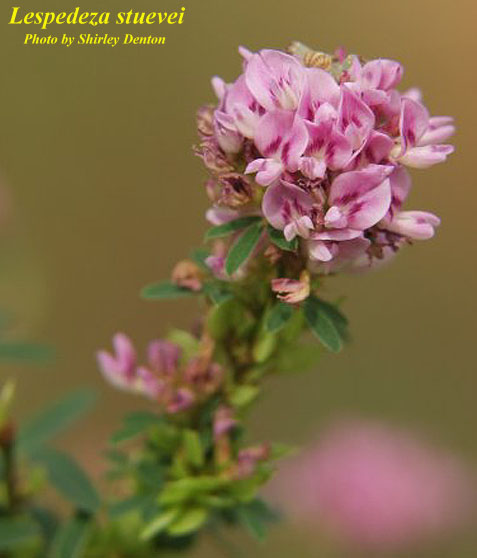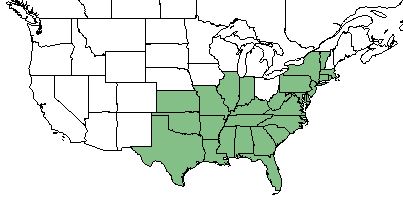Lespedeza stuevei
Common name: velvety lespedeza[1]
| Lespedeza stuevei | |
|---|---|

| |
| Photo by the Atlas of Florida Plants Database | |
| Scientific classification | |
| Kingdom: | Plantae |
| Division: | Magnoliophyta - Flowering plants |
| Class: | Magnoliopsida - Dicots |
| Order: | Fabales |
| Family: | Fabaceae |
| Genus: | Lespedeza |
| Species: | L. stuevei |
| Binomial name | |
| Lespedeza stuevei Nutt. | |

| |
| Natural range of Lespedeza stuevei from USDA NRCS Plants Database. | |
Contents
Taxonomic Notes
Synonyms: L. stuvei[1]
Varieties: none[1]
Description
L. stuevei is a perennial forb/herb of the Fabaceae family native to North America.[2] Stems erect, very leafy; leaves alternate, pinnately trifoliolate compound; leaflets 3, sparsely hairy to very hairy on the upper surface, very hairy on the lower surface, without stipels; flowers in dense clusters; fruit is a 1-seeded, indehiscent pod.[3]
Distribution
L. stuevei ranges from Massachusetts to peninsular Florida, west to Texas, and into North Carolina, Tennessee, Indiana, Illinois, Missouri, Kansas.[1]
Ecology
Habitat
L. stuevei is found in woodlands and woodlands borders.[4] Specimens have been collected from dry open upland pine woods, old field with sandy clay, disturbed open pineland, old field, roadsides, and pine-oak sand ridge.[5]
L. stuevei has shown regrowth in reestablished longleaf woodlands that were disturbed by agriculture in South Carolina, making it an indicator species for post-agricultural woodlands.[6]
Phenology
L. stuevei flowers from July through September and fruits from August to November.[1]
Seed dispersal
This species is thought to be dispersed by gravity.[7]
Fire ecology
Populations of Lespedeza stuevei have been known to persist through repeated annual burning.[8]
Conservation, cultivation, and restoration
L. stuevei is listed as extirpated by the Indiana Department of Natural Resources Division of Nature Preserves and the Pennsylvania Department of Conservation and Natural Resources, as a special concern species by the Kentucky State Nature Preserves Commission, and as threatened by the New York Department of Environmental Conservation Division of Land and Forests.[2]
Cultural use
Photo Gallery
References and notes
- ↑ 1.0 1.1 1.2 1.3 1.4 Weakley, A.S. 2020. Flora of the Southeastern United States. Edition of 20 October 2020. University of North Carolina at Chapel Hill, Chapel Hill, North Carolina.
- ↑ 2.0 2.1 USDA Plant Database https://plants.usda.gov/core/profile?symbol=LEST5
- ↑ Gee, K. L., et al. (1994). White-tailed deer: their foods and management in the cross timbers. Ardmore, OK, Samuel Roberts Noble Foundation.
- ↑ Weakley, A. S. (2015). Flora of the Southern and Mid-Atlantic States. Chapel Hill, NC, University of North Carolina Herbarium.
- ↑ URL: http://herbarium.bio.fsu.edu. Last accessed: June 2018. Collectors: Loran C. Anderson, R.K. Godfrey, A.F. Clewell, R.Kral, Richard Houk, H. Roth, V. Draig, Bill Boothe, Marcia Boothe, R. Komarek, Norman E. Hill, Delzie Demaree, H. R. Reed, R.F. Christensen, C.C. Christensen, M. Jenkins, L. Langston, C. Iversen. States and counties: Florida (Nassau, Leon, Wakulla, Jefferson, Liberty, Okaloosa, Madison, Santa Rosa, Walton, Bay, Calhoun, Jackson, Santa Rosa, Washington, Holmes) Georgia (Thomas, Charlton, Taylor, Toombs, Wheeler, Appling, Tattnall, Bulloch, Decatur, Chattahoochee, Stewart, Early, Miller, Randolph, Webster, Haralson, Marion) Mississippi (Lawrence, Franklin, Newton, Montgomery, Attala, Madison) Alabama (Calhoun, Lee, Barbour, Macon, Geneva, Bullock, Russell, Conecuh, Dallas, Lee, Tallapoosa, Lee, Henry, Mobile, Sumter, Pike, Mareengo, Clarke) Louisiana (Lincoln, Jackson)
- ↑ Brudvig, L.A., E Grman, C.W. Habeck, and J.A. Ledvina. (2013). Strong legacy of agricultural land use on soils and understory plant communities in longleaf pine woodlands. Forest Ecology and Management 310: 944-955.
- ↑ Kirkman, L. Katherine. Unpublished database of seed dispersal mode of plants found in Coastal Plain longleaf pine-grasslands of the Jones Ecological Research Center, Georgia.
- ↑ Glitzenstein, J. S., D. R. Streng, R. E. Masters, K. M. Robertson and S. M. Hermann 2012. Fire-frequency effects on vegetation in north Florida pinelands: Another look at the long-term Stoddard Fire Research Plots at Tall Timbers Research Station. Forest Ecology and Management 264: 197-209.